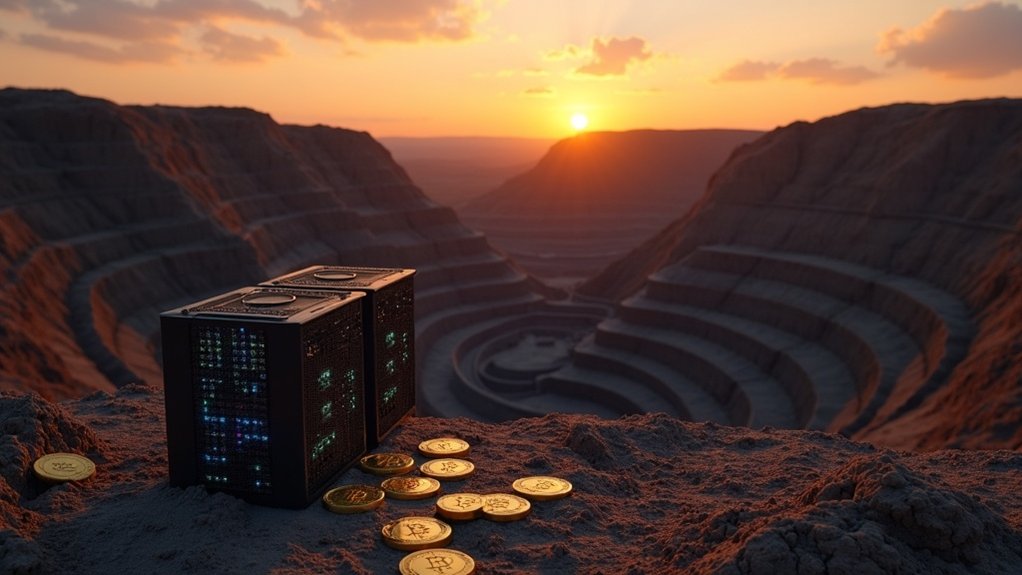Cryptocurrency farms aren’t your grandpa’s vegetable patch. They’re warehouse-sized facilities packed with specialized computers that solve complex math problems 24/7. These machines validate blockchain transactions using proof-of-work algorithms, earning digital coins as rewards. The operations guzzle electricity like teenagers raid refrigerators—often setting up near cheap power sources. Profitability hinges on a precarious balance between energy costs and mining rewards. This digital gold rush comes with serious overhead and increasing competition.
While most people struggle to understand basic computer commands, cryptocurrency farms are buzzing with machines solving complex math problems 24/7. These facilities aren’t growing digital coins in virtual soil—they’re housing rows upon rows of specialized computers that validate blockchain transactions.
Let’s be real: they’re just glorified warehouses filled with expensive, heat-generating hardware.
These farms utilize either ASIC miners (specialized chips designed for specific cryptocurrencies like Bitcoin) or GPU rigs for other mineable coins. The hardware isn’t cheap. And it’s loud. And hot. Really hot. Cooling systems are essential, unless you enjoy the smell of melting circuit boards in the morning. The difficulty level adjusts automatically to maintain consistent block creation times across the network.
The mining process itself relies on Proof-of-Work, a consensus mechanism that forces computers to repeatedly guess numbers until they find one that produces a hash meeting specific criteria. It’s basically high-tech trial and error on steroids. The SHA-256 algorithm ensures each input produces a unique 256-bit hash that’s irreversible and secure.
Proof-of-Work: computers guessing random numbers until they stumble on crypto gold. Digital lottery tickets with extra electricity bills.
When a farm successfully solves the puzzle, it adds a new block to the blockchain and earns rewards—newly minted coins plus transaction fees. The current reward stands at 3.125 Bitcoin per successfully mined block. Not a bad gig if you can afford the electric bill.
Speaking of which, these operations devour electricity like teenagers at an all-you-can-eat buffet. Operational costs are staggering. That’s why many farms set up shop near cheap power sources or in cold regions where cooling needs are reduced. Some have even turned to renewable energy, though let’s not pretend most operators are primarily concerned about their carbon footprint.
Miners select transactions from the mempool, prioritizing those with higher fees. They then construct candidate blocks with these transactions arranged in Merkle trees, repeatedly hashing with different nonce values until they hit the jackpot.
Farm operators often join mining pools to increase their chances of earning rewards, splitting the proceeds based on contributed computing power.
The math is simple: if electricity costs exceed mining rewards, you’re losing money. And with increasing competition and periodic reward halvings, staying profitable isn’t getting any easier.
Frequently Asked Questions
How Much Electricity Do Cryptocurrency Farms Consume Annually?
Cryptocurrency farms are electricity monsters.
U.S. mining facilities alone consume about 70 TWh annually, with global consumption exceeding 68 TWh and projected to hit 100 TWh.
Bitcoin mining specifically devours between 91-150 TWh yearly—more than entire countries like Finland.
That’s a staggering 0.6% to 2.3% of total U.S. electricity use.
Some operations try using renewables, but let’s be real—these digital mining operations are power-hungry beasts.
Are Cryptocurrency Farms Legal in All Countries?
No, cryptocurrency farms aren’t legal everywhere.
Some countries embrace them fully (US, Canada, EU nations), while others have slapped on restrictions or exist in legal limbo (Norway, South Africa, Zimbabwe).
Then there’s the outright ban club – China, Algeria, Bangladesh, Egypt, Iraq, and Morocco want nothing to do with crypto mining.
Others like Qatar, Tunisia, and Nepal have partial bans.
The global legal landscape? It’s a messy patchwork of acceptance, skepticism, and outright hostility.
What Happens to Mining Farms After a Crypto Crash?
After a crypto crash, mining farms get hit hard.
Less profitable operations shut down completely. The survivors? They’re forced to sell equipment, relocate to cheaper electricity regions, or switch to hosting services instead.
Local economies that once benefited take a hit too. Jobs disappear. Tax revenue dries up.
Some miners hunker down, waiting for prices to recover. Others face loan defaults and bankruptcy. Regulatory scrutiny often intensifies, adding salt to the wound.
Not pretty, honestly.
Can Mining Operations Be Environmentally Sustainable?
Mining operations can be environmentally sustainable, but reality check: they’re mostly not.
Only 2-5% currently use solar/wind energy. The rest? Fossil fuel guzzlers.
Some farms are trying—placing operations near hydropower (16%) or nuclear sources (9%).
But let’s be real. Bitcoin mining alone needs 3.9 billion trees to offset its carbon footprint. That’s several European countries of forest.
Sustainable mining requires renewable energy adoption, efficient hardware, and strict regulations.
Nice idea, tough execution.
How Do Mining Farms Affect Local Power Grid Stability?
Crypto farms can both stabilize and strain local power grids. They consume massive amounts of electricity—up to 2.3% of total US usage—which stresses infrastructure, especially in rural areas.
But here’s the twist: miners provide flexible load adjustment capabilities, rapidly curtailing operations during peak demand. They respond to price signals faster than traditional industries.
In Texas, miners draw 2,600 megawatts but can shut down immediately when needed.
Double-edged sword, really.









